|
Deciphering
the Gospels Proves Jesus Never Existed
an overview
By  - 9/1/2018
- 9/1/2018
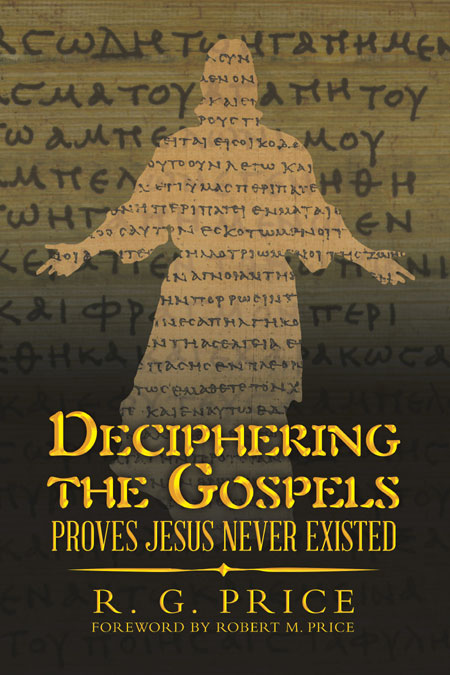
My new book, Deciphering
the Gospel Proves Jesus Never
Existed, seeks
to prove “beyond a reasonable doubt” that the Jesus of the Gospels is a
fictional character based on a heavenly messiah worshiped by a small
first century cult – evangelized by Paul. The book also explains why
the Roman elite came to believe that an otherwise unknown Jewish
prophet was the one true god of the universe and why Christianity rose
to dominance in the Roman Empire. This work is based on years of
independent research and analysis of the Gospels and other early
Christian and Jewish writings. All the primary elements of the case
presented are based on novel analysis and interpretation of ancient
texts, which are presented in full context for readers to see for
themselves. What sets this work apart from other books of this
genre is the volume of independently researched concrete
evidence that is presented to prove that various scenes and teachings
of the Gospels are ahistorical. No other work has definitively
proven that various aspects of the Gospel narrative are completely
fictional in the way that this work does.
However, the first question that arises is, can
you really prove that a
figure from ancient history didn’t exist? Isn’t that impossible to
prove? While I would concede that it is impossible to prove with
absolute certainty, it is certainly possible to prove with “reasonable
certainly.” It can be proven that Jesus never existed in just the same
way that it can be proven that Luke Skywalker never existed, or
Huckleberry Finn, or that humans were not created from clay in the
Garden of Eden, or that someone didn’t commit a crime. All of these
things are proven by proving that alternative explanations are true.
In this case it is proven that Jesus never existed
by proving that
Jesus was originally conceived as an immaterial heavenly messiah in the
pattern of other legendary Jewish figures, such as Enoch, and that the
Gospels, which are presumed to record the deeds and teachings of Jesus,
are entirely “fictional.” The case is generally proven along the
following points:
- The Gospel of Mark is a fictional work
that was written in reaction to the First Jewish-Roman War of 67-73 CE.
- All of the major scenes in the Gospel
of Mark are based on literary allusions to the Hebrew scriptures.
- The character of Jesus in the Gospel
of Mark is based on Paul and the teachings of Jesus are actually Paul’s
teachings, copied from the letters of Paul.
- The concept that Jesus was an actual
human being was introduced by the Gospel of Mark.
- Every biography of Jesus is based
directly or indirectly on the Gospel of Mark.
- The theology and descriptions of Jesus
by Paul show that he viewed Jesus as a heavenly being and had no
knowledge of a real human Jesus.
- Many early Christians believed that
Jesus was an immaterial, purely spiritual being.
- The only evidence used by early
Christians to counter the claim that Jesus was immaterial was the
Gospels.
- There are no records of the existence
of Jesus outside of the Gospels.
- The biographies of all the figures of
early Christianity are fabricated. The only figure of early
Christianity that we know anything meaningful about is Paul.
The book leads off with the most compelling
evidence in the case
against the historical veracity of the Gospels. In the first two
chapters I provide overwhelming concrete evidence that the Gospel of
Mark is an entirely fictional work written in reaction to the First
Jewish-Roman War. I show with multiple examples, that the scenes in the
Gospel of Mark are based on literary allusions and that the character
and teachings of Jesus are based on the letters of Paul. This shows
that the writer of the Gospel of Mark developed the entire narrative of
his story on his own and that the Markan narrative is not based on any
oral traditions or prior narratives about Jesus.
The next chapter shows that all of the major
scenes of the other
canonical Gospels are clearly derived from the Gospel of Mark. I show
how our understanding of the literary allusions in the Gospel of Mark
proves that none of the other Gospel writers had any knowledge of
Jesus, because they all copy scenes from Mark that originated from
literary allusions. That the scenes are based on literary allusions
means that we know they never happened and that they don’t come from
older oral traditions. That the scenes are used by the writers of the
other Gospels means that their only knowledge of the Jesus narrative is
the Gospel of Mark.
I then show, using extensive quotations from early
Christian scholars,
that the key “evidence” that led Greeks and Romans to believe that
Jesus was the one true divine Lord and embodiment of God was the
relationship between scenes in the Gospels and the Jewish scriptures. I
show that the literary allusions used by the author of Mark to craft
his narrative were interpreted by later readers as evidence that Jesus
had precisely fulfilled many ancient Jewish prophecies. I show that the
ancient Greeks and Romans believed heavily in the power and importance
of prophecy and saw prophecy as a sign of divinity. I show that the
many literary allusions created by the author of Mark, and copied into
the other Gospels, were viewed as the most thorough and concrete
evidence for divinity ever seen by the Greeks and Romans, and it was
these textual relationship that led to the adoption of the Christian
religion by Roman elites, thus leading to its official adoption as the
state religion of Rome.
Following this the book shows that many early
sects believed that Jesus
was an immaterial heavenly being, and that the only evidence used
against such claims by those that thought he was a real live person
were the Gospels. I explain that there was a great need for early
Christian sects who believed that Jesus was a real person to prove
their case, and they tried strenuously to do so, for it was a question
of major doctrinal importance. For all their efforts, the only evidence
for Jesus’s existence that early Christians could come up with was the
Gospel narratives.
From there the book goes on to shore up key
elements of the case and
address many remaining questions about how early Christian literature
and beliefs developed in the absence of a real human Jesus. I explain
why the most reasonable explanation for material in the other Gospels
that doesn’t derive from Mark is that it was itself invented by the
respective authors or was otherwise an expansion of the Markan
narrative. I address non-canonical Gospels and show that all of the
non-canonical Gospels that describe a human Jesus also show dependence
on the Gospel of Mark. I explain how the concept of a heavenly messiah
developed in Jewish culture and show that the writings of Paul clearly
indicate that Paul described Jesus as a heavenly deity who had not yet
come to Earth. Non-Christian accounts of Jesus, or lack thereof, are
addressed, showing that there are no accounts of Jesus by anyone that
show independence from the Gospel narrative. The case concludes with
evidence showing that it’s not just Jesus that never existed, but that
the entire cast of early Christian history is fabricated. Almost none
of the figures of early Christian history were real, and of the few
that were real people, such as Peter and James, virtually everything
written about them is fabricated.
Key proposals presented in the book are:
- It is explained why the Gospel of Mark
is best understood as a fictional political allegory, the narrative of
which was developed by a single individual entirely after the First
Jewish-Roman War.
- Many scenes from the Gospel of Mark are
explained as literary allusions to the Jewish scriptures.
- Many teachings of Jesus are shown to be
derived from the letters of Paul.
- James and John “Zebedee” are explained
to be the James and John described by Paul as the leaders of the early
Jesus cult (as opposed to the James described by Paul being Jesus’s
literal brother).
- A resolution to the Synoptic Problem is
proposed: The authors of Matthew and Luke both used a longer version of
Mark as their common source, in which all of the “Q” material was
already present.
- It is proposed that the author of
Matthew invented his birth narrative himself based on scriptural
references and that the author of Luke based his birth narrative on
oral accounts of the narrative from Matthew.
- It is proposed that the “miraculous
signs” narrative in the Gospel of John was invented by the author of
“John” as part of the larger anti-Jewish theme of the work.
- It is proposed that the Gospel of
“John” is a highly anti-Jewish work, in which the disciples of James
and John were intentionally omitted to blot them out of history. That
later Christian scholars attributed the Gospel to the very person that
the writer tried to eliminate from history is a major blunder of
Christian scholarship.
- It is shown that all narratives of
Jesus, including non-canonical narratives, are based on the Gospel of
Mark.
- The case is made that the best
explanation for the Testimonium
Flavianum is that it arose from the
accidental incorporation of a marginal note.
- The Eucharist ritual in 1 Corinthians
is explained as a revelation by Paul regarding the night the heavenly
Jesus was “sacrificed”, not “betrayed”. The Eucharist ritual from Paul
was used by the author of Mark in his narrative, and thus made
its way into
the Gospels.
- The works of Paul are examined to show
that Paul did not conceive of Jesus as a being that had ever been a
person on earth.
- It is demonstrated why Paul’s mention
of “James, the brother of the Lord” did not mean literal brother. It is
proposed that “James brother of the Lord” was a title of status akin to
“James the Just”, and that both titles are synonymous.
- It is demonstrated that there was need
to defend the earthly existence of Jesus as early as the late first
century, but despite much effort, no valid evidence beyond the Gospels
was ever produced.
The book does not include any diagrams or images, but the diagrams
below clarify my explanation for the development of the Gospels,
and resolutions to the Synoptic Problem.
The traditional Christian view is that the Gospels of Matthew and John
are eyewitness accounts of Jesus, while the Gospel of Mark is an
account based on the testimony of Peter and the Gospel of Luke is based
on the testimony of Paul. The traditional view is that Paul was an
independent witness to Jesus via revelation and a witness to the early
Christian community. The letters of Paul were written independently,
after the other major Gospels and not influenced by them. The
traditional view holds that all of the Gospels and letters of Paul were
written before the First Jewish-Roman War and that Jesus himself had
predicted aspects of the war. The traditional view sees the events of
the Gospels as leading to the war, with the war being a punishment from
God for the Jews having killed Jesus.
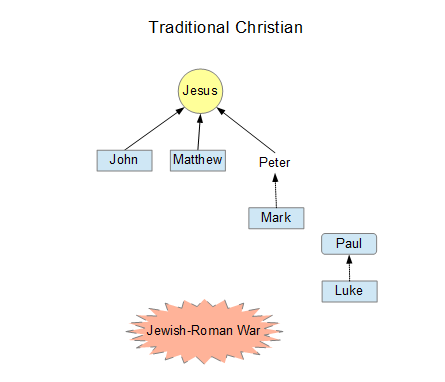
While there is no absolute modern consensus, I describe the general
modern consensus as follows: There was some real person named Jesus
whose teachings and actions inspired the early Christian movement.
Jesus's teachings and actions were preserved in some fashion via a
community of people who had witnessed his life. The oral accounts of
Jesus's teachings and actions were passed on and ultimately recorded by
various chroniclers in the Gospels and other early texts. The degree to
which the Gospels reflect Jesus's actual actions and teachings is up
for debate, but ultimately it is agreed that the Gospel narratives and
teachings are inspired by the accounts of Jesus's life. The modern
consensus holds that the Gospel narratives were developed largely
before the First Jewish-Roman War, but, for some unexplained reason,
not recorded until after the war. The modern consensus does view Paul's
writings as independent works that bear independent testimony to the
teachings of Jesus as passed on via the early Christian community.
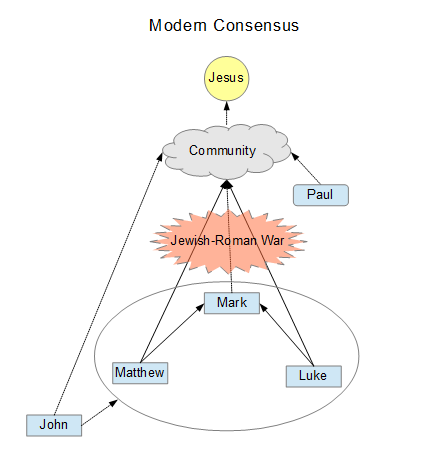
My proposal has two variations on the same theme. My proposal is that
there was no real Jesus at all. The Jesus being worshiped by the early
Christian community was an immaterial heavenly messiah. Paul was a
member of this community, though his views were in conflict with the
leadership of the community. The primary leadership of the Jesus cult
viewed the movement as a purely Jewish one, while Paul regarded Jesus
as a messiah for all people, Jews and non-Jews alike. Paul developed
his own teachings and preached them among a community of non-Jewish
followers throughout the Mediterranean prior to the First Jewish-Roman
War. Shortly after the war, some follower of Paul wrote a fictional
allegory about the cause of the war in which they cast Jesus as the
protagonist. The Jesus character in this story is based directly on
Paul himself and the teachings of Jesus in the story are Paul's
teachings, copied from his letters. The entire narrative was developed
by a single individual after the war and is not based on any prior oral
accounts. The original story was either what we currently call the
Gospel of Mark or it was a longer version that included the material
now called "Q". The Gospels of Matthew and Luke are both copied from
the longer version of Mark. That longer version is either the original
story (Full Mark) or what we now call the Gospel of Mark is the
original and a longer intermediate version (Expanded Mark) was created
by someone else. In either case, the longer version has since been
lost. The birth narrative was invented by the author of Matthew and the
author of Luke based his birth narrative on an oral account of the
narrative from Matthew. The Gospel of John is based on some combination
of the Synoptic works, either via oral accounts of them or a reading of
multiple accounts.
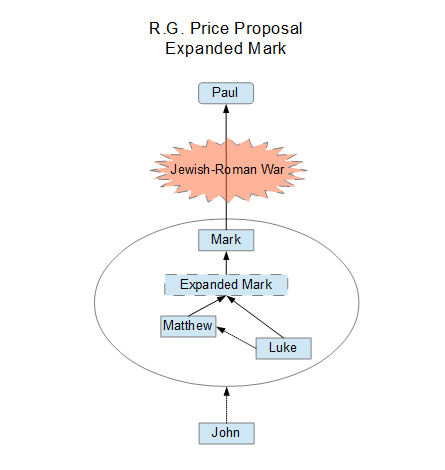 |
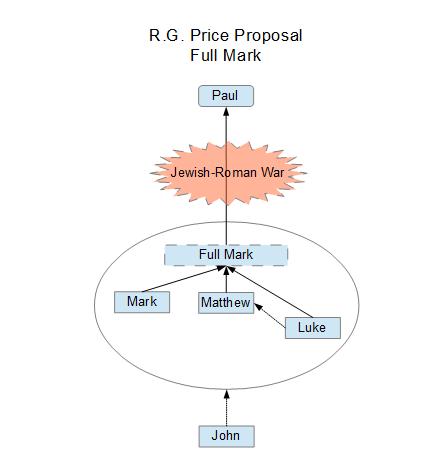 |
Reviews:
Deciphering
the Gospels Proves Jesus Never Existed is available from
major retailers:
|